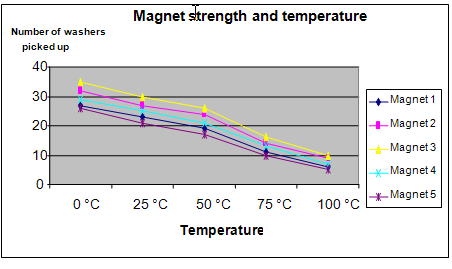| Complexity level: | 6 |
| Project cost ($): | 40 |
| Time required: | 1 day to prepare, 2 hours for the science project experiment |
| Material availability: | Easily found |
| Safety concerns: | Basic safety requirements. Handle the hot plate with care - adult supervision required |
Hypothesis
Increasing the temperature of a magnet reduces its strength.
Overview
Magnets
A magnet is an object that will produce a magnetic field around it. The magnetic field will attract ferrous materials like iron or nickel. It also attracts or repels other magnets depending, on the polarity of the other magnets.
Permanent magnets are made from materials that will remain magnetized and are hence able to maintain the magnetic field around them continuously. An example is the small magnets used to hold notes on refrigerator doors. Ferromagnetic materials like iron, cobalt and nickel have a very strong attraction towards magnets. Some ferromagnetic materials will become magnetic when exposed to a magnetic field for a long time. They will be able to retain the magnetic properties even after the field is removed. Other "soft" ferromagnetic materials will lose their magnetism once the magnetic field disappears.
When an electric current flows through a coiled wire, an electromagnet will be produced. However, when the current is removed, the magnetic properties will be lost. By placing ferromagnetic materials in the middle of the coil, the magnetic strength of the coil will be increased many times over.
Scientific Terms
Materials
The materials required for this science project::
- 5 magnets
- 200 "M4" steel washers
- 1 flat tray
- 1 hot plate
- 1 infrared thermometer
- 1 refrigerator
- 1 pair of gloves
Procedure
1. For this science project, the independent variable is the temperature of the magnet - 0 °C, 25 °C, 50 °C, 75 °C and 100 °C. The dependent variable is the number of steel washers picked up by the magnet. This is determined by counting the number of steel washers that stick to the magnet. The constants (control variables) are the size of the magnet and the weight of the steel washers.
2. Five magnets are kept in the freezer of the refrigerator overnight, in order for them to stabilize at 0 °C for use in the experiment.
3. The next day, 200 steel washers are spread over a flat tray. The 5 magnets are removed from the refrigerator and their temperatures are measured using the infrared thermometer. Be sure to set the thermometer to be able to detect "surface" temperature, rather than "body" temperature. Wearing gloves, grab a magnet and place it over the washers in the tray to pick up as many washers as possible. The results are recorded in the table given below for each of the 5 magnets.
4. The 5 magnets are placed on the hot plate until a temperature of 25 °C is reached. Procedure 3 is repeated using the same 5 magnets and the number of steel washers picked up is recorded in the table below.
5. Procedures 4 and 3 are repeated by bringing the temperature of the magnet to 50 °C, 75 °C and 100 °C, by placing them on the hot plate. The results are recorded in the table given below.

Results
It was observed that as the magnet’s temperature was increased, the number of washers picked up by the magnets reduced.
|
Magnet |
Number of washer picked up by the magnets at different temperatures |
||||
|
0 °C |
25 °C |
50 °C |
75 °C |
100 °C |
|
|
Magnet 1 |
27 |
23 |
19 |
11 |
6 |
|
Magnet 2 |
32 |
27 |
24 |
14 |
9 |
|
Magnet 3 |
35 |
30 |
26 |
16 |
10 |
|
Magnet 4 |
29 |
25 |
21 |
13 |
7 |
|
Magnet 5 |
26 |
21 |
17 |
10 |
5 |
|
|
|
|
|
The graph below represents the results of our science project experiment:

Conclusion
The hypothesis that increasing the temperature of a magnet will reduce its strength is proven to be true.
Magnetism and magnets have found many uses in products that we use daily. The once popular cassette and video tape were made using a reel of magnetic tape. Our ATM cards and credit cards have a magnetic strip which contains information. Magnetism is also used in transformers, motors, speakers, microphones and many more devices. Hospitals use Magnetic Resonance Imaging (MRI) to identify problems in patients, without having to perform surgery. .
Also consider
Try to repeat the science fair project experiment, using an electromagnet.
The science project can also be repeated by using magnets made from different materials.
References
Magnet - http://en.wikipedia.org/wiki/Magnet
Cold and magnets - http://www.newton.dep.anl.gov/askasci/phy00/phy00146.htm
How magnets work - http://www.howmagnetswork.com/

